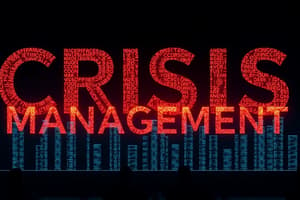Podcast
Questions and Answers
What is the primary purpose of establishing a crisis team before a crisis occurs?
What is the primary purpose of establishing a crisis team before a crisis occurs?
- To conduct market research for recovery strategies
- To develop an effective plan for handling emergencies (correct)
- To manage public relations during a crisis
- To evaluate past crises and improve future responses
Which analysis techniques can help prioritize potential crises based on their likelihood and impact?
Which analysis techniques can help prioritize potential crises based on their likelihood and impact?
- Financial forecasting and SWOT analysis
- Market segmentation and customer feedback
- What If analysis and Scenario Analysis (correct)
- Employee surveys and trend analysis
In crisis planning, why is defining roles important early in the process?
In crisis planning, why is defining roles important early in the process?
- To limit the number of participants in the crisis team
- To ensure compliance with industry standards
- To reduce costs associated with training
- To facilitate clear communication and responsibilities (correct)
What should be included in a crisis response plan?
What should be included in a crisis response plan?
How can an organization measure the end of a crisis and readiness for recovery?
How can an organization measure the end of a crisis and readiness for recovery?
What is a recommended method to ensure that the crisis response plan is effective?
What is a recommended method to ensure that the crisis response plan is effective?
Which of the following is NOT a suggested stage in crisis management planning?
Which of the following is NOT a suggested stage in crisis management planning?
What immediate action did Johnson & Johnson take in response to the Tylenol crisis?
What immediate action did Johnson & Johnson take in response to the Tylenol crisis?
What type of crisis can result from severe social media criticism?
What type of crisis can result from severe social media criticism?
Which of the following is NOT mentioned as a type of crisis that could impact an organization?
Which of the following is NOT mentioned as a type of crisis that could impact an organization?
What benefit did Johnson & Johnson gain from its effective crisis management during the Tylenol incident?
What benefit did Johnson & Johnson gain from its effective crisis management during the Tylenol incident?
What does the survey by Steelhenge reveal about many organizations' approach to crisis management?
What does the survey by Steelhenge reveal about many organizations' approach to crisis management?
Which company is cited as an example of poor crisis management due to lack of preparedness?
Which company is cited as an example of poor crisis management due to lack of preparedness?
What was one of the major costs incurred by Johnson & Johnson during the Tylenol crisis?
What was one of the major costs incurred by Johnson & Johnson during the Tylenol crisis?
Which of the following impacts can a crisis have on an organization beyond financial losses?
Which of the following impacts can a crisis have on an organization beyond financial losses?
Flashcards are hidden until you start studying
Study Notes
Crisis Management
- In 1982, the Tylenol crisis resulted in the death of seven people after capsules were tampered with, leading to product recall and new tamper-resistant packaging.
- Johnson & Johnson's swift response was praised and attributed to their established crisis management plan.
- A 2014 survey showed that while most companies have a documented crisis management plan, almost a third were created after a crisis.
- Crises not only impact finances but can lead to the loss of licenses to operate.
Types of Crises
- Technological emergencies such as industrial accidents or software failures.
- Customer/protester boycotts and picketing.
- Malicious product tampering and industrial espionage.
- Organizational misdeeds, such as Volkswagen's emissions scandal.
- Malicious misinformation campaigns that damage reputation.
- Transport disruptions that affect supply chains.
- Matthew Seeger, Timothy Sellnow, and Robert Ulmer identify the key elements of all crises: a threat to the business, unexpected occurrence, and a short window for reaction.
Planning for Crisis Management
- Most crisis management plans involve creating a crisis team, identifying key risks, developing a crisis plan, and planning for full recovery.
Stage 1: Establishing a Crisis Team
- Establish a crisis team before any crisis happens.
- Appoint individual responsible for the crisis plan.
- Implement stakeholder management to effectively communicate with teams.
- Define roles early in the planning process to establish clear guidelines.
- Ensure the plan aligns with the organization's ethical values.
Stage 2: Identifying Key Risks
- Identify everyday situations that could escalate into a crisis.
- Consider potential threats, including illness/death of key staff, customer/supplier dependence, and political developments.
- Prioritize risks based on their likelihood and impact.
- Use "What If" Analysis, Scenario Analysis, and Risk Impact/Probability charts to prioritize.
- Learn from industry experiences and past company crises.
- Involve stakeholders such as insurance companies and law enforcement agencies.
Stage 3: Developing the Plan
- Create a detailed plan to effectively respond to each key crisis.
- Ask key questions about crisis identification, procedures, resources, communication, and recovery criteria.
- Keep asking "If this happens, what do we do?" and create "If____, then ____" recommendations.
- Include criteria, procedures, equipment, contacts, resources, and communication plans for each crisis.
- Communicate the plan to everyone involved.
- Use the Recognition-Primed Decision Process to aid decision-making under pressure.
- Regularly review and revise the plan.
- Conduct full simulations to test the plan and identify shortcomings.
Stage 4: Plan for Full Recovery
- Determine how to return to business as usual quickly.
- Secure external suppliers for essential services.
- Create a plan to bring critical operations back online after an emergency.
- Offer post-crisis support to employees, such as counseling or flexible working hours.
Key Points
- Planning is crucial for surviving and managing a crisis.
- Crisis planning is an essential part of proactive and effective management.
- Establishing a crisis team, identifying key risks, developing a crisis plan, and planning for full recovery are crucial steps.
Studying That Suits You
Use AI to generate personalized quizzes and flashcards to suit your learning preferences.




